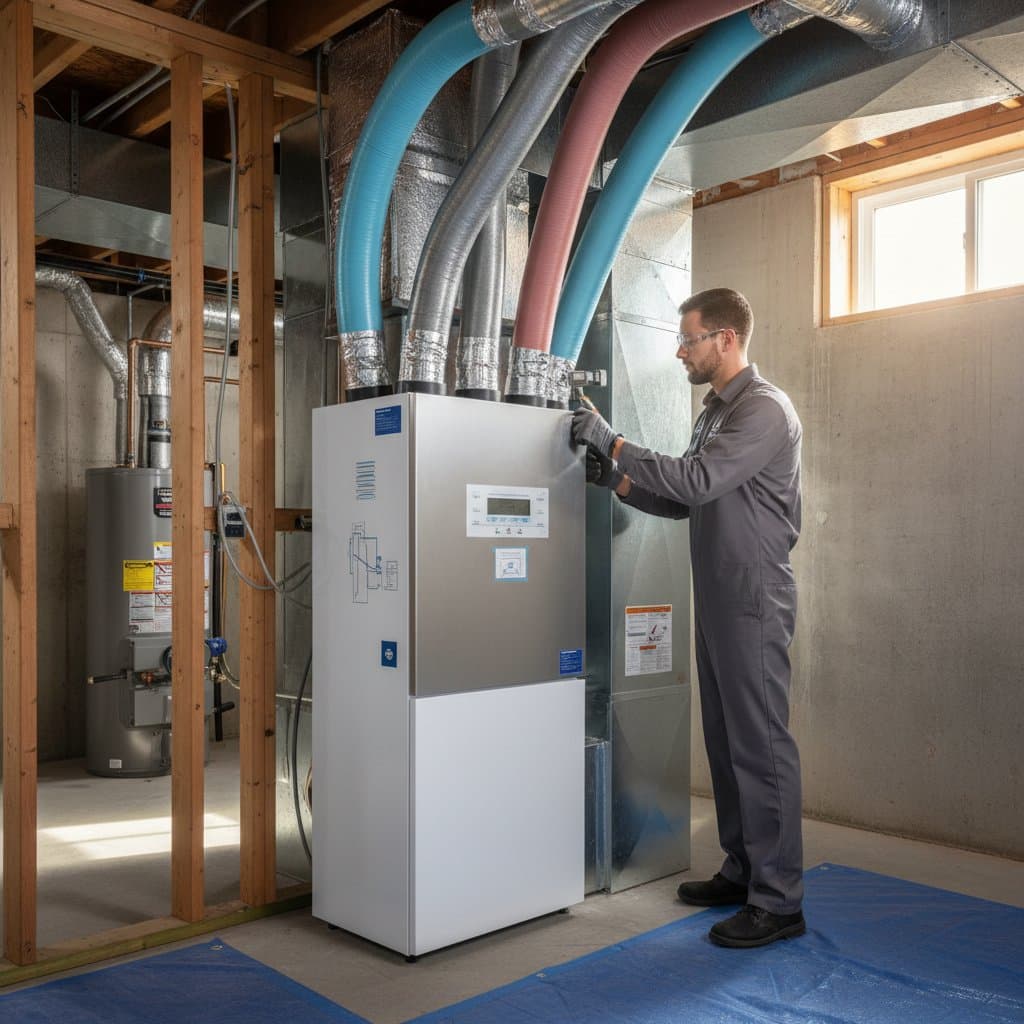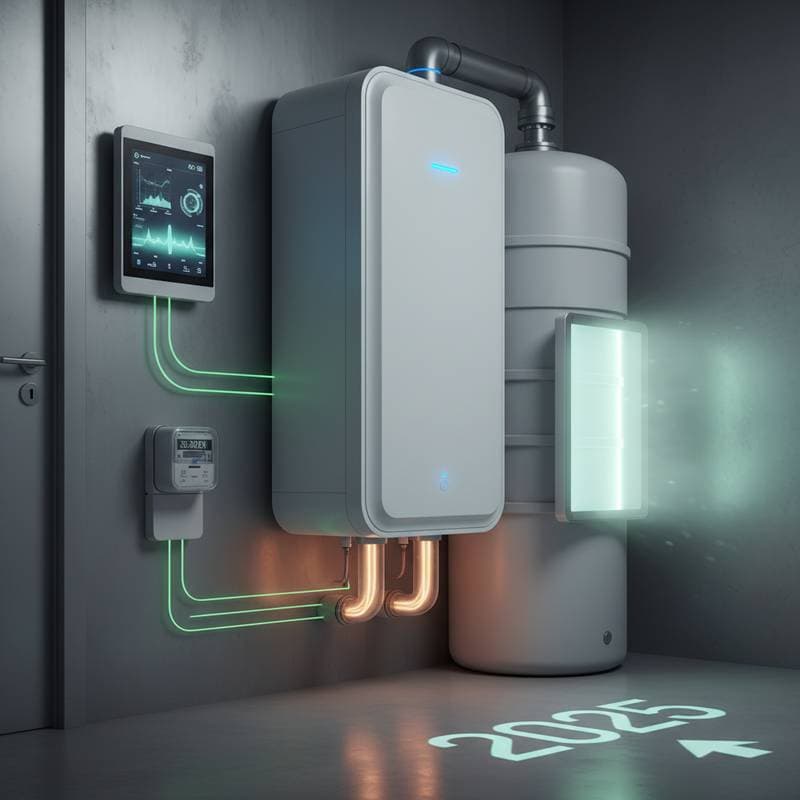Energy Recovery Systems Reduce Winter Heating Bills by 55 Percent in 2025
Heating bills rise sharply each winter for many homeowners. Maintaining comfort becomes challenging without excessive costs as temperatures fall. Energy recovery systems now enable homes to lower winter heating expenses by up to 55 percent. This overview explains heat recovery ventilator operations, energy conservation benefits, and suitability assessments for residential use.
Understanding Energy Recovery Systems
An energy recovery system captures heat or coolness from exhaust air and applies it to precondition incoming fresh air. In homes, heat recovery ventilators (HRVs) and energy recovery ventilators (ERVs) represent the primary options.
These units introduce outdoor air without dissipating furnace-generated warmth. A central core facilitates heat transfer, and sometimes moisture exchange, between exhaust and intake air streams. This mechanism stabilizes indoor temperatures and lightens the HVAC workload.
In essence, an HRV or ERV enables clean air circulation while retaining purchased heat.
Mechanisms for Reducing Winter Heating Expenses
Cold outdoor air demands extra effort from heating systems to reach comfortable levels. Absent an energy recovery unit, this air enters unconditioned. With such a unit, exhaust air heat warms the incoming supply.
Preconditioned fresh air requires less furnace or heat pump energy to achieve setpoint temperatures. Cumulative efficiency yields substantial bill reductions over time.
Savings vary by climate, insulation quality, and unit efficiency, yet studies indicate reductions in heating energy consumption up to 50 percent. Such outcomes prove significant during peak cold periods when costs escalate.
Indicators That Your Home Needs a Heat Recovery Ventilator
Assess potential benefits by examining these ventilation shortcomings that compromise energy use or comfort:
- Elevated heating bills despite conservative thermostat adjustments
- Stale or excessively humid indoor environments
- Window or wall condensation in cold conditions
- Temperature inconsistencies across rooms
- Subpar air quality or persistent odors
- Drafts originating from fans or structural leaks
Tightly sealed homes, optimized for efficiency, often lack adequate ventilation. An HRV or ERV delivers balanced air exchange without heat loss, suiting contemporary airtight builds.
Factors Influencing Energy Recovery System Effectiveness and Expenses
Evaluate performance and pricing influencers prior to installation. Consider these elements:
-
Unit Capacity and Sizing
Match the system to home square footage and air exchange requirements. Undersized units fail to circulate sufficient air; oversized ones consume unnecessary energy. -
Core Technology Type
HRVs handle heat transfer exclusively, whereas ERVs manage heat and moisture. Selection hinges on regional climate and humidity profiles. -
Installation Demands
Retrofitting established homes exceeds new-build complexity. Duct configurations and access determine labor expenses. -
Efficiency Specifications
Premium models involve higher initial costs yet deliver greater long-term savings. Prioritize units with superior heat recovery rates. -
Upkeep Obligations
Routine filter and core maintenance proves essential. Designs with accessible panels ease ongoing care. -
Labor Costs and Regional Variations
Installation fees differ by location; expert setup guarantees proper balancing and sealing.
Expect professional installations to range between mid-tier furnace and central air conditioner prices. Energy bill reductions typically recoup investments within a few years.
Comparing HRV and ERV Systems
Both systems enhance efficiency through distinct approaches. The following details their distinctions.
Heat Recovery Ventilator (HRV)
HRVs exchange heat between air streams without moisture transfer. They excel in cold, arid regions where humidity control remains straightforward. These units refresh air while minimizing heat escape.
Energy Recovery Ventilator (ERV)
ERVs manage heat and moisture exchanges to regulate indoor humidity. They benefit areas with dry winters or humid summers by preserving comfort alongside energy gains.
Select an HRV for severe cold exposure. Opt for an ERV if dry indoor air poses issues during winter, allowing moisture retention with heat recovery.
Steps in the Energy Recovery System Installation
Professional execution maximizes system reliability and safety. The process unfolds as follows:
-
Site Evaluation
Technicians analyze home layout, current HVAC setup, and ventilation demands. They map airflow routes and pinpoint optimal unit placement. -
Unit Recommendation
Assessment findings guide HRV or ERV type and size selections tailored to the property. -
Physical Setup
Install the unit in a utility space or attic, linking it to intake and exhaust ducts. Incorporate dampers and fans for airflow control. -
System Calibration and Verification
Measure airflows to confirm balanced intake and exhaust. Equilibrium avoids pressure imbalances that impair heating performance. -
Owner Orientation
Receive guidance on filter servicing, seasonal inspections, and control adjustments post-installation.
Flawless installation remains vital. Faulty ductwork or imbalances diminish returns. Engage certified HVAC specialists exclusively.
Handling Maintenance: DIY Tasks and Professional Services
Manage basic care independently, but delegate complex work to experts.
Owner-Managed Tasks
- Inspect and refresh air filters quarterly
- Clear intake and exhaust grilles of accumulations
- Ensure vent obstructions from furnishings or weather are absent
- Clean the unit exterior periodically
Expert Responsibilities
- Core inspection and decontamination
- Airflow testing and adjustments
- Electrical and fan integrity checks
- Condensate line clearance verification
Avoid tampering with enclosed elements or electrical systems. These units integrate electrical components and may interface with primary HVAC infrastructure. Professionals maintain optimal operation and safety.
Common Questions About Energy Recovery Systems
Do energy recovery systems achieve 55 percent reductions in winter heating bills?
Affirmative, in optimal scenarios. Properly integrated into sealed homes, HRVs or ERVs reclaim substantial exhaust heat. Reductions reach 50 percent in heating demands, contingent on climate and habits.
How frequently must heat recovery ventilator filters receive attention?
Examine filters bimonthly; clean or replace based on condition. Accumulated debris hampers airflow and efficiency, impacting performance and air purity.
Do energy recovery systems operate quietly?
Contemporary designs minimize noise. Expect gentle airflow akin to a low-setting exhaust fan. Unusual vibrations or whines warrant professional diagnosis for setup or balance corrections.
Can energy recovery systems integrate with current HVAC setups?
Yes, compatibility extends to most forced-air systems. Connection to ductwork allows seamless operation with furnaces or heat pumps for efficient air management.
Do energy recovery systems justify investment in temperate regions?
Certainly, they elevate air quality and alleviate HVAC burdens regardless of climate. Though savings prove modest, enhanced comfort and health advantages render them worthwhile.
Advancing Your Home Toward Greater Efficiency
Address escalating bills and poor air circulation this season through energy recovery adoption. Contact a licensed HVAC expert for a personalized assessment to initiate improvements.





